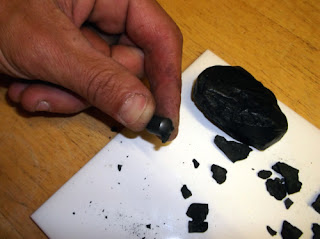 1- Jet black mineral as yet unidentified it is attracted to none rare earth magnets, resistant to very high temperatures.
1- Jet black mineral as yet unidentified it is attracted to none rare earth magnets, resistant to very high temperatures.
2 Video of a visit to a section of Cleveland dyke in Teesdale. Sorry for the quality of the video's but the conditions were not great.
 4 - Cobble worked from the Cleveland dyke at Stainton quarry, the none rare earth magnet sticks to the Basaltic andesite quite easily.
4 - Cobble worked from the Cleveland dyke at Stainton quarry, the none rare earth magnet sticks to the Basaltic andesite quite easily. 5- Large piece of whin stone not far from Stainton quarry, again the none rare earth magnet sticks easily.
5- Large piece of whin stone not far from Stainton quarry, again the none rare earth magnet sticks easily. 7- Left over stone at the Stainton quarry site, all of the rocks easily attracted none rare earth magnets.
7- Left over stone at the Stainton quarry site, all of the rocks easily attracted none rare earth magnets. .8 - Excavated rock from the The Stainton gravel beds Ime sure its Whinstone but am not sure what has caused the indentations, but whenever i come across whinstone with these marks, it has a very strong attraction to none rare earth magnets
.8 - Excavated rock from the The Stainton gravel beds Ime sure its Whinstone but am not sure what has caused the indentations, but whenever i come across whinstone with these marks, it has a very strong attraction to none rare earth magnets 9- 11 This piece is strange, Excavated from The Stainton gravel beds
9- 11 This piece is strange, Excavated from The Stainton gravel beds 12 Excavated from The Stainton gravel beds
12 Excavated from The Stainton gravel beds
16- These curb stones run along the Boothem area of Central York, all i tested were attracted to the rare earth magnet shown, i did not have a none rare earth magnet with me, but would gamble one would easily stick,as ime sure these stones originated from one of the quarry's in The south west area of Cleveland.
 17 - 18 show an experiment i carried out, please click the link for more info and images Magnetic horse bone
17 - 18 show an experiment i carried out, please click the link for more info and images Magnetic horse bone
19 Another experiment.














































